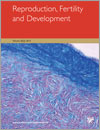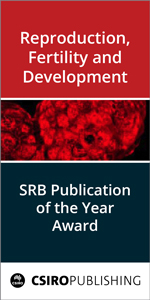Reproduction, Fertility and Development
Volume 26
Number 2 2014
High-producing dairy cows are subfertile, which may be due to premature ovarian senescence. In the present study, 5% of the total population of culled dairy cows (4–8 years old) has several distinctive features of premature ovarian failure, such as a reduced antral follicle count, ovarian reserve, low anti-Müllerian hormone concentrations in the follicular fluid and poor in vitro oocyte developmental competence. This population may represent a model to address can address the causes of reduced fertility in high-yielding dairy cows, as well as the condition of premature ovarian aging in single-ovulating species.
Heat stress has long been considered an important cause of compromised fertilisation in farm animals. The objective of this study was to investigate the signalling pathway by which bovine spermatozoa react to heat stress. The results show that mitogen-activated protein kinase (MAPK) 14 is the key signalling pathway, and inhibition of this pathway can possibly be an interesting option for minimising the adverse effects of heat stress.
This series of experiments represents the first attempt to manipulate meiosis in oocytes from the domestic cat, using chemicals that affect intracellular concentrations of cyclic adenosine monophosphate (cAMP). Although the effects of decreasing cAMP degradation (inhibition of meiosis) were consistent with other species, the effects of increasing cAMP production (stimulation of meiosis) were unique to feline oocytes. Such species-specific effects emphasise the need for comparative studies in taxa like Carnivora, where basic information about reproductive biology is limited.
Primitive male germ cells (gonocytes) from cattle have glycan epitope α-N-acetylgalactosamine (GalNAc) residues, which are recognised by the lectin Dolichos biflorus agglutinin (DBA), on their cell surface. In culture, DBA-coated culture dishes can effectively trap gonocytes and support their survival and proliferation. The GalNAc–DBA complex supports colony formation, germ cell and stem cell potentials of gonocytes in vitro and provides a useful system to analyse the role of cell surface glycan epitopes on early spermatogenesis.
Uterine secretions/histotroph provides essential nutrition to the developing conceptus during early pregnancy. The objective was to examine the effects of stage of cycle and concentration of circulating progesterone on the availability of amino acids and glucose in the uterine environment during the pre-implantaion period of conceptus development. Total recoverable quantities of 22 amino acids were greater on Day 13 compared with Day 7; and on Day 13, the amounts of Asn, His and Thr were lower in a low P4 environment. Stage of oestrous cycle and progesterone play important roles in modulating amino acids in histotroph, a potentially critical factor for early embryonic/conceptus survival.
In search of new non-hormonal and non-steroidal contraception therapies, the potential of liver receptor homologue-1 (LRH-1) as a drug target was explored. Temporary downregulation of LRH-1 in female mice resulted in complete infertility that was fully reversible, with microarray expression analysis revealing that multiple aspects of the ovulation process were affected, most prominently progesterone biosynthesis. The data support the development of an LRH-1 antagonist for contraception.
The human Y chromosome is susceptible to structural rearrangements because of the repetitive nature of its genetic sequences, and partial deletions in the Y chromosome are often linked to male infertility. Herein we identified and characterised one of the genetic configurations without sY1191 at the AZFc locus. The results exemplify the prevalence of variations in the human Y chromosome among infertile men.
Selection for ovulation rate is an indirect way to improve litter size. Ovulation rate variability between breeds may be associated with transcriptome profiling. In the present study, we investigated causes of low ovulation rate in the Brazilian Piau breed compared with a commercially available line. Piau gilts exhibited a different pattern of follicle development and higher ‘activity’ of cell death genes. This helps elucidate the genetic control of prolificacy and achieve genetic gains in litter size.
The steroid hormone progesterone (P4) plays a central role in the establishment and maintenance of pregnancy. The present study examined the effect of short-term P4 supplementation on conceptus development in cattle and showed that although exogenous progesterone was beneficial to the early conceptus, in some cases it resulted in compromised corpus luteum function. The results indicate that P4 supplementation strategies aimed at stimulating corpus luteum development may be most effective.
The identification of markers of oocyte quality would have significant benefits for assisted reproduction in domestic animals and in humans. The aim of this study was to identify non-invasive markers of oocyte quality by examining the components of the follicular fluid in which the oocyte develops and the somatic cells associated with it. The observed association between follicular fluid metabolites and oocyte developmental competence could be useful for selecting the best eggs for IVF, or to optimise the IVF protocol.
Complete fertilisation failure is an emotional tragedy for patients receiving in vitro fertilisation treatment. To detect early sign of fertilisation and prevent oocyte ageing, we evaluated the extrusion of the second polar body prior to pronuclei development. Our results showed early rescue intra-cytoplasmic sperm injection on oocytes without extruding the second polar body 4 hour following insemination is an effective method to prevent complete fertilisation failure for patients with mild or moderate male infertility.
Pre-eclampsia is a serious pregnancy complication. There are currently no efficacious treatments available to halt disease progression besides delivery of the baby and placenta; thus, clinicians are often forced to deliver infants regardless of gestation. Herein, we show that the placental-specific protein pregnancy-associated plasma protein A2 (PAPPA2) is increased in severe early onset pre-eclampsia and up regulated with hypoxia. Given the pathogenesis of pre-eclampsia is so poorly understood, characterisation of proteins upregulated in this disease is essential if better biomarkers or treatment options are to be identified or developed.
The oviduct plays a crucial role in sperm storage, maintenance of sperm viability and sperm transport. We investigated the effects of oviductal cell culture passage number, oviductal cell age and spermatozoa–oviduct coincubation times on gene expression in oviductal cells. The data suggest that the oviductal cells lose some of their properties as a result of aging. This has important implications for the study of spermatozoa–oviduct interactions in in vitro cell culture systems.




